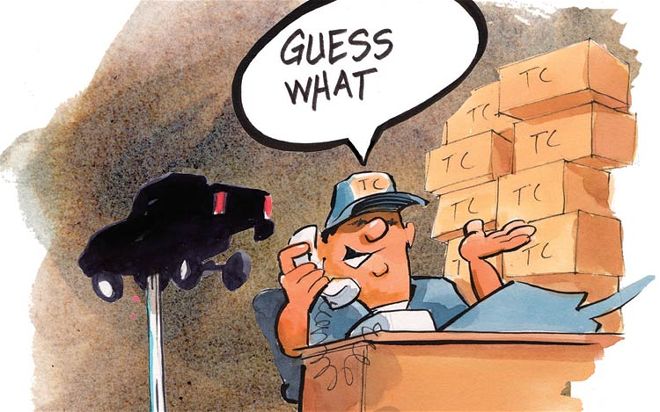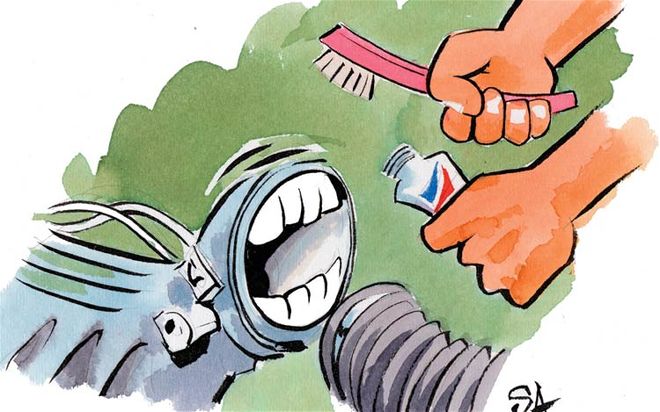Flakey Fuel Pump?Q: My 2000 Chevy Tahoe 4x4 has the 5.3-liter V-8 and 100,000 miles. It's beginning to develop an intermittent problem. When I drive it a short distance, say to the store, I come back out and the engine cranks and acts like it's going to start, but then it won't. It's almost like it isn't getting any gas. If I let it sit for 15 or 20 minutes, it'll start. This happens every couple days or so. I've changed the fuel filter, plugs, and wires. It was starting and running better than it had in quite a while; however, four days later, the problem came back. What I should check next?
A: A lot of things can cause an engine to intermittently crank but not start. It could be a fault with idle air control, a failure in the ignition system, or various types of fuel-delivery problems, to name a few. All systems should be inspected and tested by a qualified technician. The most common cause of this type of complaint is often a fuel-pressure issue--more than likely, it's the fuel pump itself. If you are the original owner of the vehicle and unaware of the fuel pump having been replaced previously, that's another clue. Many fuel pumps don't last 100,000 miles. However, there also could be a fault in the fuel-pump's electronic circuitry, such as a bad fuel-pump relay, or a missing signal from the powertrain control module that activates the pump circuit. A technician would probably use a scan tool to check for trouble codes, look for incorrect incoming data or outgoing commands, and then test the pressure with a fuel-pressure gauge. It should read between 55 and 62 psi with the ignition on and the engine off. The next time it happens, and you have a passenger on board, ask him to work the ignition while you remove the gas cap and listen for a hum from the fuel pump in the tank. You should hear it for a couple seconds when the ignition is turned on and continuously while cranking. This information may be helpful to a technician working on the job, especially if he's having difficulty duplicating the condition in the shop.

| 163 0702 Expert Advice 02z
Earth-Quaking TransQ: I have a 2000 Chevy pickup with the 6.0-liter engine. Last year, when I was using it to tow my trailer, it was shifting rough. The dealership updated the computer calibration, and it seemed to run fine for a while, then it started to happen again, this time without the trailer. Now it's clunking in all gears, up and down. I was told I needed a new torque converter. Are there any other problems to consider before I spend the big money?
A: Let's not try to fix anything that isn't broken. Right now, you should focus on the shifting problem. I presume what you've described as a rough shift is a late and/or hard engagement. You know, almost snapping your neck back during a 1-2 or 2-3 upshift. Communication between vehicle owners and technicians can be misleading. That's part of the reason why a good long road test is so important when evaluating a transmission-related driveability concern. I'm bringing this up because harsh shifting is typically not a symptom of torque-converter failure. Usually there's a loss of power or poor acceleration, noise, vibration, shuddering, or a complete lack of engagement. The technician who diagnosed the condition may have found solid evidence that I'm not aware of to support the torque-converter replacement, or it could be a misdiagnosis. Harsh shifting can be caused by a number of hydraulic or electronic faults. If you're not sure about the converter replacement, get a second opinion from a qualified Chevrolet service department or specialty transmission shop.
Throttle-Body HygieneQ: I recently replaced the EGR valve in my 6.0-liter V-8-powered 2000 GMC Sierra 2500 because at idle it would stumble, randomly, and there was a lot of hesitation on acceleration as if the engine was choking. Since I replaced the valve, the hesitation is gone, but I'm still getting erratic idle at random, when the engine is warm. There aren't any engine lights or codes. Could this be the engine coolant-temperature sensor?
A: We can't give you a concrete answer, but here are two areas to focus on. Number one is cleaning out the throttle-body assembly. Carbon builds up on the back of the throttle plate and within the throttle bore. These accumulations come from the EGR gases emitted into the engine and can become a problem as mileage increases. The carbon buildup limits the air intake needed for quality idle control. Fixing it is a simple job you can do yourself. With the engine off, remove the rubber intake duct from the throttle-body assembly, open the throttle plate, and reach in with a rag saturated in GM Top Engine Cleaner. Keep wiping until almost all the accumulation is gone. You can even use a toothbrush to get into the nooks and crannies. It's also a good idea to bring the truck into a GMC service department to have the PCM updated with the latest calibration. This may help the computer compensate for future throttle-body accumulation and also deal with noted tip-in hesitations. Another component that may be responsible for an intermittent rough-idle condition or misfire are the fuel injectors. Injectors can become obstructed by fuel contaminants. A pressure-drop test of the injectors, with the use of special tools, can determine which injectors are obstructed, which need to be replaced, and which may be saved with the help of a direct injector-cleaning procedure. The special cleaning tool uses the same GM Top Engine Cleaner, which is good stuff. There also have been problems with corrosion at the fuel-injector electrical terminals causing intermittent driveability concerns.

| 163 0702 Expert Advice 03z
Fighting off the SludgeQ: My 1989 Bronco II has the six-cylinder 2.9-liter engine and a five-speed manual transmission. After sitting all night, the truck takes three or four tries before it'll remain running. It starts and runs for about a second or two and then dies. Once it stays running, it's fine the rest of the day. I checked the fuel pressure, and it's good according to the book: 40 psi when the key is turned on and about 34 psi while it's running. It also holds 40 psi for quite a while if I let it sit when it's not running. If this problem is the idle bypass valve, could you tell me how to check it, or give me some other troubleshooting ideas? No malfunction lights are on.
A: Like many other throttle body and port fuel-injected engines, carbon buildup on the throttle bore and plate or idle air control (or bypass) valve and passages can cause issues with idle quality and stalling. Cleaning out the carbon often becomes an unavoidable but relatively infrequent service procedure. More recently developed air-intake systems are designed to minimize or even eliminate the conditions associated with carbon buildup. In your case, along with a bunch of other 1984 to 1992 model-year Fords, there's an alternative fix to the carbon problem (or sludge, as Ford calls it). Ford developed a service kit with directions on cleaning the air-intake components, a detailed adjustment procedure, and the addition of a spacer plate beneath the idle air-control valve intended to permanently eliminate idle symptoms due to the sludge accumulation. Service kit 9F939 should fit your 1989 Bronco II, and instructions are included. As always, the source of the condition should first be confirmed and other possible causes of stalling eliminated before buying any parts. But if sludge is the culprit, you have a choice between repeated cleaning as maintenance, or a kit to install as a one-time repair.
Good Vibrations GoneQ: My 2003 Toyota 4Runner V-8 Sport has two annoying traits that Toyota won't correct. First, when coming to a stop, completely stopped, or upon brake release, there's a pushing sensation like a clunk. Secondly, there's a slight vibration in the steering wheel, console, and armrests when the vehicle is under load at about 1200 to 2000 rpm. I also can feel it when the vehicle is stopped in Drive, foot on the brake, A/C on or off. Under acceleration there's an accompanying moaning or groaning sound. Although Lexus has issued several TSBs for the 4Runner's sister vehicle, the Lexus GX 470, Toyota insists these are "normal operating characteristics" of the 4Runner. My local Toyota dealer test drove, acknowledged, and documented the problems, but since there are no TSBs, can do nothing.
A: We'd hoped Toyota would've come out with something by now, but we couldn't find anything, either. Lexus TSB # DL001-04 refers to a driveline clunk when coming to a stop, with a new propeller shaft (part #37110-6A480) used as a fix. This pertains to 2003 and 2004 Lexus GX 470s built prior to a certain production point. While it sounds like the same condition on the same platform and drivetrain, there's nothing published that applies the repair to the 4Runner. And then there's Lexus TSB # ST004-04 dealing with a steering vibration and/or front driveline "drone" on the GX, which we experienced on the GX and the 4Runner when they first came out. This repair kit involves a vibration damper installation on the front differential and an intermediate shaft and slip yoke replaced at the steering column. We spoke with the folks at Toyota communications when the problems first came about, who say there haven't been enough complaints recorded on the Toyota side to warrant a TSB. Your best bet is to speak with the Toyota zone service manager who handles the dealership where you bought the vehicle. Be nice, have a friendly approach, and explain the situation. See if he can perform the Lexus TSBs on your Toyota in an attempt to correct your problems. Perhaps you can work something out.

| 163 0702 Expert Advice 04z
Alex Gives Buying AdviceQ: My wife and I are thinking of trading her small car for an SUV. We have narrowed it down to a 4Runner or a Lexus RX. It'll be driven a lot of highway miles, but we need the extra room for the things we like to do.
A: We always side with quality, reliability, and overall performance as opposed to bells, whistles, or saving a buck. That said, you're on the right track by narrowing it down to Toyota/Lexus. If your wife is the sporty type who enjoys getting to places in the backcountry, go with a four- or two-wheel-drive 4Runner. It's one of the toughest out there, yet comfortable for highway use or lunch with the girls. However, most women seem to prefer the more plush travel in an RX 330/350. It's a little smaller, priced a bit higher, and you can't really do any trail exploring with it like the 4Runner, but there's a reason for the high volume in RX sales. It's a soccer-mom-functional SUV with the Lexus brand of luxury for under $40K, and the front-drive model gets about 25 mpg on the highway--not to mention the care you typically get at the Lexus service department. Personally, we'd go for the 4x4 V-8 4Runner, tack on a TRD supercharger, a TRD suspension lift, big off-road tires, and 4.11:1 gears--but that's just us.
Taking Off TaillightsQ: I need to remove the driver-side taillight from my 2005 Cadillac SRX (don't ask me to explain). I pulled the interior plastic molding away, but didn't see any screws to free the taillight. Can you provide any assistance?
A: Keep digging. Presuming you removed the correct trim panel located behind the taillamp, there's still more work to do before you can get to the nuts that hold the taillamp assembly in place. On the right side, you have to remove the rear speaker. Then you can undo the two nuts and remove the taillamp. On the left, to get to the taillamp nuts, remove the auxiliary blower motor fasteners and tilt the motor outward. It's worth noting that a small amount of condensation accumulating within a taillamp, or any other ventilated lamp assembly, is considered normal. If there's a fine mist or white fog in the corners that doesn't cover more than half the lens and appears only under humid conditions, don't replace the lamp assembly. The moisture should clear up in drier conditions or while driving with the lights on for an extended period of time. You may also compare both sides. If one has the same slight fog as the other, chances are it's normal. On the other hand, if you see water droplets covering more than half the lens, one lens is much wetter than the other, the water appears after rain or car wash, a puddle accumulates in the bottom of the lens, or it doesn't eventually clear up with the lights on, then you have a real water leak that will require replacement of the assembly.
Finding Your TSBQ: I was reading your response to a question about a vibration in a 1995 Dodge Ram, but when I went to locate the Technical Service Bulletin you mentioned, I was unable to find it. Can you tell me where I can pull it up and read it?
A: The question you're referring to was about a 1995 Ram 2500 Club Cab that produced a vibration at various speeds. Just as I mentioned in that reader's case, a vibration can stem from a number of areas--tires, wheels, suspension, the driveline, and more. More than likely it can be quickly diagnosed by an able technician. At the same time, I brought up Dodge TSB number 23-48-96. It dealt with a vibration felt in the seat of your pants, corrected by the installation of a modified transmission mount and a reinforcement procedure to a crossmember. This fix involved 1995 and 1996 Club Cab Rams built prior to March 15, 1996. If you're interested in a TSB description and procedure, I suggest asking for a copy at your local Dodge service department. This is an involved correction requiring several hours' labor time. And it may not be the heart of your Ram's problem. Have the truck checked out while you're there.
How To Reach AlexIf you have a technical question regarding your pickup, SUV, or van, feel free to contact Alex, a master technician with the National Institute for Automotive Service Excellence. Send a letter to him in care of Truck Trend Garage, 831 S. Douglas Street, El Segundo, CA 90245, or e-mail us at trucktrend@sourceinterlink.com. Please include the VIN with your question. Due to the volume of questions received every month, we cannot guarantee that everyone's question will be personally answered or will appear in the magazine.
Can't wait for help with a problem you're having with your Truck or SUV? Ask the expert we trust here at Truck Trend Garage--visit Alex Steele at www.RealWorldAutomotive.com.
 | 163 0702 Expert Advice 02z
Earth-Quaking Trans
| 163 0702 Expert Advice 02z
Earth-Quaking Trans | 163 0702 Expert Advice 03z
Fighting off the Sludge
| 163 0702 Expert Advice 03z
Fighting off the Sludge | 163 0702 Expert Advice 04z
Alex Gives Buying Advice
| 163 0702 Expert Advice 04z
Alex Gives Buying Advice